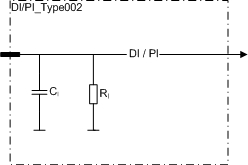
This type of pin is a ground referenced input (DI) including a pulse counting (PI) feature.
Pulse inputs can be used as a 1 or 2 channel pulse counter and they have a reset possibility. Possible software channels and pairs are listed in section SW channels for Pulse Inputs.
This type of pin has no configurable features
Electrical characteristics
|
Symbol |
Parameter |
Conditions |
Min |
Max |
Units |
|
RI |
Input Resistance |
|
typ. 12,4 |
kΩ |
|
|
VIH |
Input High Voltage level |
(Note 1) |
6,2 |
50 |
V |
|
VIL |
Input Low Voltage level |
|
0,0 |
4,1 |
V |
|
VI-max |
Max Input voltage |
(Note 6) |
-5 |
60 |
V |
|
fI |
Input Frequency |
tC= 4ms (Note 2,3,4,7) |
|
250 |
Hz |
|
Input Frequency |
(Note 5,8) |
5 |
20000 |
Hz |
|
|
tI |
Input Pulse Width (pulse counting) |
(Note 5) |
0,025 |
250 |
ms |
|
CI |
Input pin capacitance |
|
typ. 1 |
nF |
|
Note 1: Exceeding the max values might cause damage to input.
Note 2: These parameters depend on software cycle time.
Note 3: Applies to inputs used as normal digital input. Violating this rating may lead to application program not noticing all input state transitions.
Note 4: Pulse width must be greater that the software cycle time. For example with 50/50 pulse ratio, the pulse frequency is 1 / (2*pulse width)
Note 5: Violating this rating may lead to system not recognizing all input state transitions.
Note 6: Overload conditions.
Note 7: tC denotes software cycle time.
Note 8: Max value can be reached by 2-98% pulse ration.

|
|
Refer to section Connection Examples to see examples of how to connect external actuators or sensors when using this type of pin. |